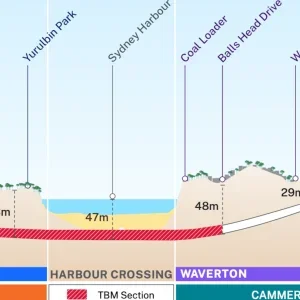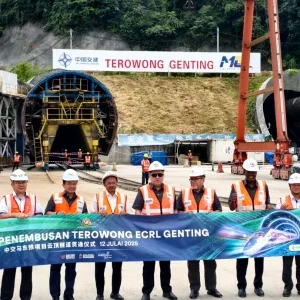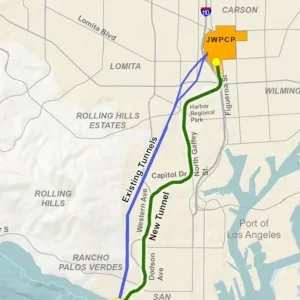Singapore’s Land Transport Authority (LTA) has accepted a proposal from contractors for a new tunnel alignment and change in methodology for the re-build of the Circle Line MRT tunnels and station at Nicoll Highway. The move follows last April’s collapse of the area during cut and cover construction that claimed the lives of four workers (T&TI, October 2004, p6).
The Nishimatsu Construction Co. Ltd/Lum Chang Building Contractors Pte Ltd. JV (NLC) was main contractor for the Nicoll Highway works as part of contract C824 on the 5.2km Circle Line Stage One when tragedy struck on 20 April 2004. A retaining wall gave way during open cut tunnelling works leaving a 30m deep hole that opened across six lanes of the highway for roughly 150m.
As the civil works contractor for the Nicoll Highway and Boulevard Mass Rapid Transit (MRT) stations and adjacent tunnels, NLC is also the contractor for the reconstruction of the MRT tunnel and station at Nicoll Highway.
NLC proposed a new alignment that places the re-built Nicoll Highway MRT station some 100m to the south of the collapsed area. The LTA announced its acceptance of the proposals on 4 February this year.
A new 1.8km length of twin tunnels will be built from the west end of the Boulevard station towards the Millenia station. The route will cross through the marine clay of the Kallang Basin and will be approximately 25m deep.
The realigned tunnels will now be bored by two TBMs from a launch shaft near the Boulevard station. The TBMs will drive through the new Nicoll Highway station to a reception shaft midway between Millenia and Nicoll Highway stations. Other bored sections on this stage of the scheme have used 5.8m i.d. bolted and gasketed segmental linings.
The new Nicoll Highway station will be constructed using the top down method. This differs significantly from the original design that involved excavating between strutted retaining walls to the final depth, followed by casting of a base slab and subsequent progressive lifts of structural pours.
The top down method involves constructing 1.5m thick diaphragm walls to a depth of 60m, socketed into hard strata, followed by a relatively shallow excavation to a depth of only 6m where the roof slab will be cast. The roof slab will subsequently act as a robust strut while excavation continues below through openings in the slab.
The concourse level will then be cast immediately the correct depth is reached and will act as additional bracing until the base slab is cast. This method should address some of the factors believed to have contributed to the collapse last year, such as rising loads in the retaining wall struts and uplift or displacement of the retaining wall lower edges.
Construction is due to get underway later this year, with NLC providing a new project team for the reconstruction works. The LTA will also have a new project team to implement improvements in the way the contract is administered. These include engaging an independent consultant to carry out temporary works design checks, appointing an instrumentation consultant to report directly to the LTA with regards monitoring of structural elements.
A Committee of Inquiry (COI) was launched last year to investigate the causes of the incident. It aims to reach a conclusion by April.
Related Files
Plan showing the location of the collapse last year and the new alignment







